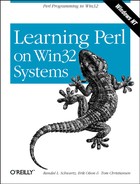In order for automation controllers and servers to cooperate, they
have to have some way to agree on the type of data that they’re
passing. Automation accomplishes this through a data type called a
VARIANT
.
The VARIANT data type is built on a C-language
union. It contains a type field that identifies that type of data in
the union (things such as strings, numbers, automation objects, etc.)
and a field that contains the data.
Usually, Perl handles data-type conversion for you. If you need more
control, though, you can create a
Variant
object and specify the type yourself. Perl provides access to the
types listed in Table 19.3.
Table 19-3. Variant Types
|
Variant Type |
Description |
|---|---|
|
VT_UI1 |
Unsigned character (1 byte) |
|
VT_I2 |
Signed integer (2 bytes) |
|
VT_I4 |
Signed integer (4 bytes) |
|
VT_R4 |
Floating point (4 bytes) |
|
VT_R8 |
Floating point (8 bytes) |
|
VT_DATE |
OLE Date (floating-point value measuring days since midnight, Dec. 30, 1899) |
|
VT_BSTR |
OLE String |
|
VT_CY |
OLE Currency |
|
VT_BOOL |
OLE Boolean |
By default, Perl converts integer data to the VT_I4 type, string data to the VT_BSTR type, and floating-point data to the VT_R8 type. Usually, these conversions are what you’d expect, but let’s look at how you might specify your own type:
$vt = new OLE::Variant(OLE::VT_DATE, "May 31, 1997" );
$Message->{TimeSent} = $vt;This example first creates a Variant object, setting the type to
VT_DATE and the date to “May 31,
1997.” It then assigns the date to the
Message object TimeSent property (something you
might do if you were posting a message to a folder, for example).
